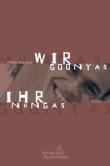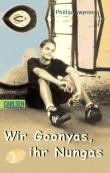AustLit
Latest Issues
AbstractHistoryArchive Description
'"Deadly, unna?" He was always saying that. All the Nungas did, but Dumby more than any of them. Dumby Red and Blacky don't have a lot in common. Dumby's the star of the footy team, he's got a killer smile and the knack with girls, and he's a Nunga. Blacky's a gutless wonder, needs braces, never knows what to say, and he's white. But they're friends... and it could be deadly, unna? This gutsy novel, set in a small coastal town in South Australia is a rites-of-passage story about two boys confronting the depth of racism that exists all around them.'
Source: Publisher's blurb.
Adaptations
-
form
y
 Australian Rules
( dir. Paul Goldman
)
Australia
:
Tidy Town Pictures
,
2002
Z931436
2002
single work
film/TV
(taught in 2 units)
Australian Rules
( dir. Paul Goldman
)
Australia
:
Tidy Town Pictures
,
2002
Z931436
2002
single work
film/TV
(taught in 2 units)
In Prospect Bay, a remote fishing town in South Australian, the only thing that connects the two communities - the Goonyas (whites) and the Nungas (blacks) - is football. The underlying racism and class warfare threatens to make the team's greatest victories irrelevant, though. Two members of the team, Gary Black (the son of a white fisherman) and Dumby Red (the team's star player), are an exception, however, having been best friends since childhood despite their different cultural and family backgrounds. The jubilation that occurs when the team wins the local premiership is short-lived when Dumby is inexplicably overlooked for the 'best on ground' award. This incident subsequently sets off a chain of events that ends in tragedy.
[Sources: Weekend Australian 22-23 December 2001 pp.14-15 and Australian Screen]
Notes
-
Prequel to Nukkin Ya.
Publication Details of Only Known VersionEarliest 2 Known Versions of
Other Formats
- Braille and sound recording.
Works about this Work
-
Aboriginal Perspectives in English Classroom Texts
2019
single work
criticism
— Appears in: English in Australia , vol. 54 no. 1 2019; (p. 20-29)'According to the NSW K–10 English Syllabus, all students should engage with ‘texts that give insight into Aboriginal experiences in Australia’. Along with the inclusion of the Aboriginal and Torres Strait Islander Cross Curriculum Priority, this suggests that texts in English should develop deep understanding of Aboriginal cultures, experiences and perspectives. This project uses critical discourse analysis followed by content analysis, adapted from Lowe and Yunkaporta’s (2013) Cultural Analysis Matrix, to analyse representations of Aboriginal experiences and perspectives in six commonly used classroom texts to ascertain the nature and depth of the Aboriginal voices, experiences and perspectives within each text. This paper argues that texts which include Aboriginal characters and experiences through non-Aboriginal perspectives remain at risk of tokenism and/or shallow inclusion. However, texts which embody and value Aboriginal ways of knowing, doing and being demonstrate a capacity for more nuanced and genuine insights into Aboriginal experiences in Australia.'
Source: Publisher's blurb.
-
The Gift and the Ethics of Representing Aboriginality in Australian Children's Literature
2016
single work
criticism
— Appears in: Australian Aboriginal Studies , no. 2 2016; (p. 33-45)'This paper draws on theories of the gift to address the ethics of representing Aboriginality in Australian children's literature, which is a contentious debate that centres on who is eligible to tell Aboriginal stories and how the stories can be told. Considering the historical indebtedness in Australian racial relations, the paper suggests that children's books that incorporate reference to Aboriginal cultural elements constitute a metaphorical 'gift' exchange between Aboriginal custodians as the givers and writers as the recipients who are expected to 'return' such an intellectual gift through their books in an appropriate manner. In this view, the paper specifies the ethical issues confronted by non-Aboriginal writers for children, including Patricia Wrightson, Phillip Gwynne and Kate Constable, and examines the way in which the gift relationship sheds light on the question of how to avoid infringement of Aboriginal protocols without submitting to self-censorship. A caring gesture, underlining the relationship between self and others in gift exchanges, is identified to negotiate the writer's interests in Aboriginal stories with cultural sensitivity against unauthorised appropriation. The paper therefore argues that the morality of gift exchanges, which demands a balanced consideration of disparate interests in obligatory reciprocation, offers a possible solution to the dilemma of non-Aboriginal writers in the treatment of Aboriginal subject matter.' (Publication abstract)
-
Respecting Protocols for Representing Aboriginal Cultures
2014
single work
criticism
— Appears in: JASAL , vol. 14 no. 3 2014; 'This essay undertakes a detailed discussion of how respecting protocols for representing Indigenous cultures supports the interests of Indigenous communities and producers of stories with Indigenous content. To highlight the importance of Indigenous protocols I review the prominence and reception of Aboriginal stories in Australian film and literature and discuss how protocol guidelines can prevent problematic representations. I demonstrate how protocols influenced writing Calypso Summer (2014), a novel exploring issues relating to my cultural group, the Nukunu, to illustrate the challenges encountered and benefits gained from employing Indigenous representation protocols. ' (Author's introduction) -
Phillip Gwynne - Ideas?
2013
single work
column
— Appears in: Reading Time : The Journal of the Children's Book Council of Australia , February vol. 57 no. 1 2013; (p. 5) -
[Review] Deadly, Unna?
2011
single work
review
— Appears in: Fiction Focus : New Titles for Teenagers , vol. 25 no. 4 2011; (p. 55-56)
— Review of Deadly, Unna? 1998 single work novel
-
[Review] Deadly, Unna?
1998
single work
review
— Appears in: Reading Time : The Journal of the Children's Book Council of Australia , August vol. 42 no. 3 1998; (p. 39)
— Review of Deadly, Unna? 1998 single work novel -
Cover Book : Deadly, Unna?
1998
single work
review
— Appears in: Magpies : Talking About Books for Children , May vol. 13 no. 2 1998; (p. 24)
— Review of Deadly, Unna? 1998 single work novel -
Reading and Viewing : Aboriginal and Torres Straits Islanders Texts for Years 9 and 10
2011
single work
review
— Appears in: English in Australia , vol. 46 no. 2 2011; (p. 92-93)
— Review of Bran Nue Dae 2009 single work film/TV ; Deadly, Unna? 1998 single work novel ; Riding the Black Cockatoo 2009 single work autobiography -
[Review] Deadly, Unna?
2011
single work
review
— Appears in: Fiction Focus : New Titles for Teenagers , vol. 25 no. 4 2011; (p. 55-56)
— Review of Deadly, Unna? 1998 single work novel -
[Review] Deadly, Unna?
2000
single work
review
— Appears in: Fiction Focus : New Titles for Teenagers , vol. 14 no. 2 2000; (p. 61)
— Review of Deadly, Unna? 1998 single work novel -
A Late Starter
2003
single work
column
— Appears in: The Age , 18 August 2003; (p. 4) -
The Children's Book Council of Australia Annual Awards 1999
1999
single work
criticism
— Appears in: Reading Time : The Journal of the Children's Book Council of Australia , August vol. 43 no. 3 1999; (p. 3-12) -
CBC Acceptance Speeches : Phillip Gwynne
1999
single work
column
— Appears in: Reading Time : The Journal of the Children's Book Council of Australia , November vol. 43 no. 4 1999; (p. 2-3) -
Talking Up Your Story
2005
single work
column
— Appears in: The Age , 9 May 2005; (p. 12-13) -
'If I've Arsked Youse Boys Once, I've Arsked Youse Boys a Thousand Times!': Translation Strategies in the German Translation of Phillip Gwynne's Deadly Unna
2007
single work
criticism
— Appears in: Papers: Explorations into Children's Literature , May vol. 17 no. 1 2007; (p. 51-56) This paper is concerned with the 'textual and extratextual' constraints imposed upon a work when it is translated, specifically how certain Australian cultural signifiers are transferred from the original source text to a German target text through the acts of translation (p.51). Gerber uses the novel Deadly, Unna? as an example of the complexities and possible problems involved in translating narratives which highlight a specific cultural context, in this case, relations between the indigenous and non-indigenous people of a small rural community which culminate around the town's local football team.
Awards
- 2022 nominated Deutsche Jugendliteraturpreis — Youth book
- 2002 nominated German Youth Literature Award — Youth book Wir Goonyas, ihr Nungas
- 2000 winner Festival Awards for Literature (SA) Adelaide Festival Awards for Literature South Australian Literary Awards — Children's Literature Award
- 1999 winner CBCA Book of the Year Awards — Book of the Year: Older Readers
- 1999 winner Children's Peace Literature Award
- South Australia,
- Country towns,






